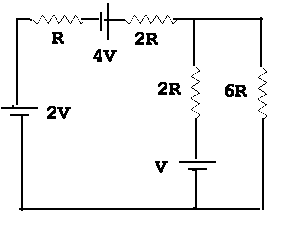 2. (30 points) Starting from Gauss's Law, determine the capacitance
of a parallel-plate capacitor, whose plates are a long and
b wide and are placed a distance d apart.
2. (30 points) Starting from Gauss's Law, determine the capacitance
of a parallel-plate capacitor, whose plates are a long and
b wide and are placed a distance d apart.
EXAM 2 April 15, 1998 PHYS 208
Name:________________________________________________________
If you would like to change your grade-posting code, enter a 6-8 character code suitable for public display below. If you wish, tell me not to post your scores at all, whether or not you have previously given me a code to use.
Code:_____________________
| g = 9.8 m/sec2 | Radius of the earth = 6.38 x 106 m |
| The mass of the electron is 9.11 x 10 -31 kg. | e = 1.60 x 10 -19 C |
1
-------------- = 9.0 x 109 N m2/C2
4 pi epsilon0
|
mu0 ---- = 1 x 10-7 Henry/m 4 pi |
1. (10 points)
(a) Give the physical argument for the loop rule for analyzing
circuits [one of the two rules for obtaining equations to be used in
determining the currents in a circuit].
(b) Give the physical argument for the junction rule for analyzing ciruits [the other rule for obtaining equations].
 2. (30 points) Starting from Gauss's Law, determine the capacitance
of a parallel-plate capacitor, whose plates are a long and
b wide and are placed a distance d apart.
2. (30 points) Starting from Gauss's Law, determine the capacitance
of a parallel-plate capacitor, whose plates are a long and
b wide and are placed a distance d apart.
3. (30 points) Write down equations which, when solved, will give the currents through each resistor in the circuit in the diagram. Do not attempt to solve the equations.
4. (30 points) A loop is made of a length L of limp
wire which behaves like a conducting string. The loop lies on a
horizontal, frictionless table. A uniform magnetic field
B is directed vertically.
(a) What happens when a current I is passed through the wire?
You may choose to consider any convenient initial shape. Does the
final shape of the loop depend on its initial shape?
(b) What is the net magnetic force on (any) half of the wire (size and direction)?
(c) What is the tension in the wire when the current is flowing?